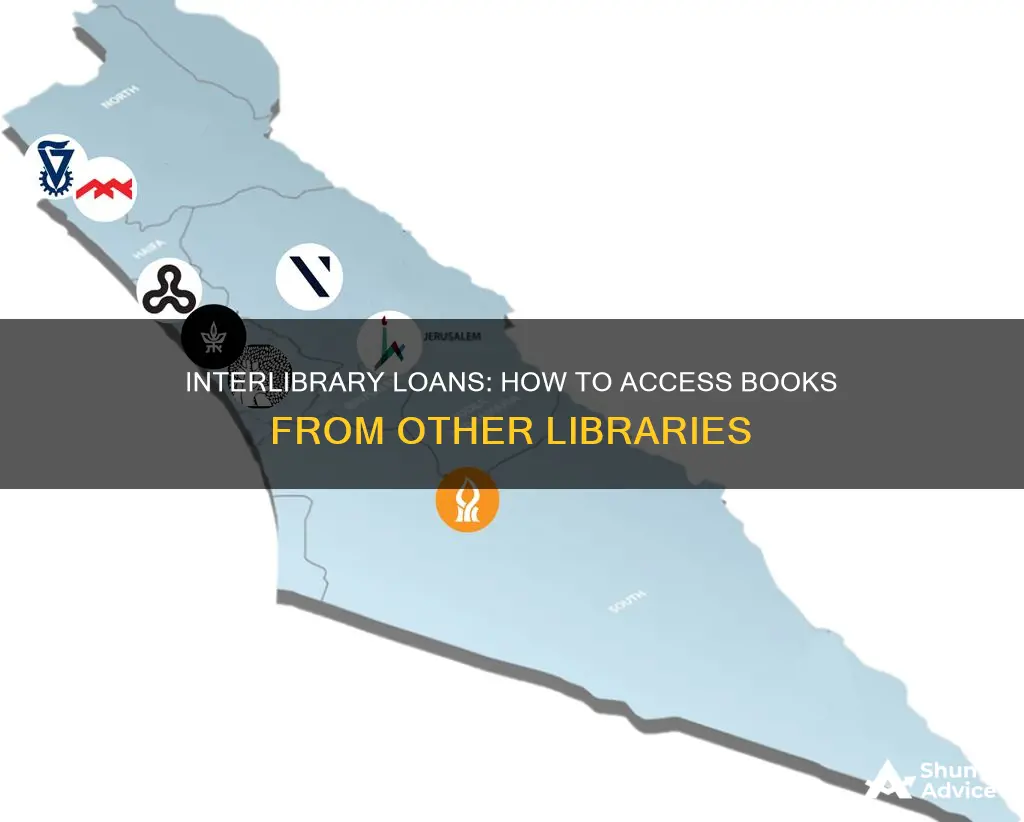
Interlibrary loans (ILL) are a great way to access books, articles, and other materials that your local library may not have. The process involves your library reaching out to other libraries to borrow the desired item on your behalf. While ILLs are a common practice, not all libraries offer this service, and it's worth checking with your local library to see if they participate in interlibrary loans. The process can vary depending on the library, with some libraries allowing patrons to make requests themselves, while others handle the entire process. It's important to note that ILLs are not always guaranteed, and factors such as the rarity or demand for an item can affect the success of your request.
What You'll Learn

How to request an interlibrary loan
Interlibrary loans (ILL) are a great way to access books, articles, microfilm, DVDs, CDs, and other materials that your local library doesn't have. The process for requesting an interlibrary loan may vary depending on your library and the item you're requesting, but here are some general steps to follow:
- Check if your library offers interlibrary loans: Not all libraries offer this service, so it's important to verify before making a request. Search for "interlibrary loan" on your library's website or ask a librarian if they provide this service.
- Identify the item you want to request: Note the title, author, and any other relevant details of the item you wish to borrow.
- Submit a request: You can usually submit an ILL request online, by phone, or in person at your local library. Some libraries allow you to make requests directly through their online catalog or databases. If you are requesting an article or book chapter, you may receive a scan or PDF via email.
- Wait for a response: It may take a few days to several weeks to receive a response from the lending library. Your library will notify you once the item has arrived or if there are any issues with your request.
- Pick up the item: Once the item arrives at your library, you will be notified, and you can go to the library to pick it up.
- Return the item: Keep in mind that there may be specific guidelines or time limits for returning the borrowed item. Make sure to return it on time to maintain good relationships between libraries.
Remember that each library has its own policies and procedures for interlibrary loans. Some libraries may have restrictions on the types of materials they lend or borrow, and there may be costs associated with the lending library that you will be responsible for. Always check with your local library staff for specific instructions and guidelines.
Jewelers' Reports: Loans or Something Else?
You may want to see also

Interlibrary loan history
The practice of interlibrary loans is not a new concept. Informal borrowing and lending between libraries have been occurring as far back as the 8th century in Western Europe. For example, an 8th-century copy of St. Augustine's "De Trinitate" in the Bodleian Library contains a page that was left blank at the end of the manuscript. On this page, "an Anglo-Saxon hand of about the year 800 entered a small list of books", which was likely a "catalog" of manuscripts in the ancient library of St. Kilian's at Würzburg, with several books loaned to Holzkirchen and the monastery at Fulda.
In the 16th century, Nicolas-Claude Fabri de Peiresc, a French researcher and astronomer, attempted to establish an interlibrary loan system between the Royal Library at the Louvre Palace in Paris and the Vatican Library in Rome. This attempt was unsuccessful due to bureaucratic reasons. In 1876, Massachusetts librarian Samuel Swett Green published a proposal for an interlibrary loan system modeled on European examples, expressing the potential usefulness of such a system for reference libraries.
In 1886, Joseph C. Rowell, a librarian at the University of California, Berkeley, sought permission to begin an interlibrary loan program. Rowell initiated Berkeley's first program of interlibrary lending with the California State Library in 1894. In 1917, the American Library Association established a national code for interlibrary loans in the United States. Internationally, the First World War led to an increase in international lending and borrowing between libraries, resulting in the establishment of the International Federation of Library Associations and Institutions (IFLA) in 1927. Formalized interlibrary loan policies were also established in China as early as 1924 through the Shanghai Library Constitution.
In 1994, the Reference and User Services Association (RUSA) of the ALA formed an Interlibrary Loan Code for the United States. In 1998, the China Academic Library and Information System (CALIS) was launched as a Beijing-based academic library consortium that facilitates interlibrary loans among research libraries in China.
How 401k Loans Work: Your Balance and Beyond
You may want to see also

Interlibrary loan guidelines
Interlibrary loans, or ILLs, are a great way to access books, movies, and other resources that your local library may not have. Here are some guidelines to help you navigate the process of requesting an interlibrary loan:
Finding Out If Your Library Offers ILLs
Start by checking your library's website to see if they offer interlibrary loans. Not all libraries advertise this service, so if you're unsure, ask a librarian. They will be able to provide you with the most accurate information.
Making a Request
Once you've confirmed that your library offers ILLs, you can make a request for the item you're looking for. This can usually be done through the library's website or with the help of a librarian. Be prepared to provide as much information as possible about the item you're requesting, including the title, author, and any relevant details.
How ILLs Work
After you've made your request, your library will search for the item in other libraries within your city, county, or state. If necessary, they may even search out of state. Once they find a library that has the item, they will make a request, and the item will be shipped to your library if the request is accepted. Keep in mind that the lending library may deny the request for various reasons, such as high demand or rarity of the item.
Timing and Availability
The time it takes to receive an ILL can vary depending on several factors, including the location of the lending library and the shipping process. In some cases, it may take a few weeks or even up to six weeks to receive your requested item. Additionally, the number of items you can request through ILL at one time and the loan period may differ from library to library.
International ILLs
Interlibrary loans are not limited to within a single country. The International Federation of Library Associations and Institutions (IFLA) guides interlibrary loan policies internationally. When seeking a loan from a library outside your country, follow the guidelines provided by the IFLA.
By following these guidelines, you can take advantage of interlibrary loans to access a wider range of resources beyond what your local library offers. Remember that each library may have its own specific procedures, so don't hesitate to ask your librarian for guidance throughout the process.
Multiple Buyers: Boon or Bane for Loans?
You may want to see also

Interlibrary loan in other countries
Interlibrary loans are a service that allows patrons of one library to borrow materials from another library. The International Federation of Library Associations and Institutions (IFLA) guides interlibrary loan policies internationally. The mechanics of shipping a book to another country are often complicated by the need to negotiate various courier options and customs offices. International interlibrary loans are influenced by external political, economic, social, and technological factors. For example, the current international financial situation has impacted libraries, with acquisitions budgets being slashed and staff numbers being reduced, which has had an impact on interlibrary loan services.
Interlibrary loan services are available in several countries outside of the US. In France, the PEB ILL network services over 300 libraries using the SUPEB ILL software. In Germany, Bavarian libraries, including the Bavarian State Library, use Gateway Bayern (GB) as their ILL network and tool. The National Library of New Zealand (Te Puna Mātauranga o Aotearoa) is a resource-sharing hub. DELNET, the Developing Library Network, is a resource-sharing network supporting India and South Asia. The National Diet Library of Japan is a resource-sharing hub for Japanese-language materials domestically and internationally. The China Academic Library and Information System (CALIS) is a Beijing-based academic library consortium that facilitates interlibrary loans among research libraries in China. Formalized interlibrary loan policies were established in China as early as 1924 through the Shanghai Library Constitution.
In Pakistan, modernization has provided scholars with access to the latest information resources, allowing them to compete in the international market. Turkey has seen increased interlibrary loan activity due to its young population and growth in university research output. Botswana has reported sophisticated demands from a growing readership with specialized skills.
In Florida, the Seminole County Public Library ended its interlibrary loan program in 2011 due to declining use and increasing costs. However, other libraries in the state, such as the Broward County library, continue to offer interlibrary loan services.
How Bonuses Affect Loan Eligibility and Income Assessment
You may want to see also

Interlibrary loan FAQs
Interlibrary loans (ILL) are a way to request a book your library does not have from another library. Your library checks with other libraries in your city, county, or state (and sometimes out of state) for the book. They make the request to a library that has the item, and then the request is accepted or denied. If accepted, the book is shipped to your library, and you are notified when it arrives.
You can search for "interlibrary loan" on your library's website. If it's not listed, ask a librarian if it's available, as not all libraries list this service on their website.
You can request an interlibrary loan in person, by phone, by using an online form, or by email. Some libraries allow patrons to log in to their website and make the request themselves. Alternatively, a library staff member can make the request for you.
The time it takes to receive an interlibrary loan depends on various factors, including the availability of the item and the distance it needs to travel. In some cases, it may take up to six weeks to receive an interlibrary loan.
Yes, some items may not be available for interlibrary loan due to their rarity, fragility, or copyright restrictions. Additionally, libraries may not lend out new or high-demand items.
If the item you are looking for is not available through interlibrary loan, you can ask your library if they can purchase it. Libraries typically consider factors such as patron demand, budget constraints, and collection development when deciding whether to purchase a requested item.
Uninsured Loaner: What Does My Insurance Cover?
You may want to see also
Frequently asked questions
Check your library's website or ask a librarian if they offer interlibrary loans.
Interlibrary loans let one library borrow a book, article, or microfilm reel from another library. Your library checks other libraries in your city, county, or state (sometimes out of state) for your book. They make the request to a library that has the item and then accept or deny the request. If they accept the request, the item will be shipped to your library, and you’ll be notified when it arrives.
The time it takes to get an interlibrary loan varies. In Michigan, it typically takes about a week for shipping between libraries, while in Kentucky, it can take up to six weeks.
It depends. If the lending library charges a fee, your library will need to pay for the interlibrary loan. Patrons may be responsible for replacement costs if the item is damaged or lost in transit. Additionally, some libraries may purchase a copy of the requested item if they cannot obtain it through interlibrary loan and there is sufficient demand.







